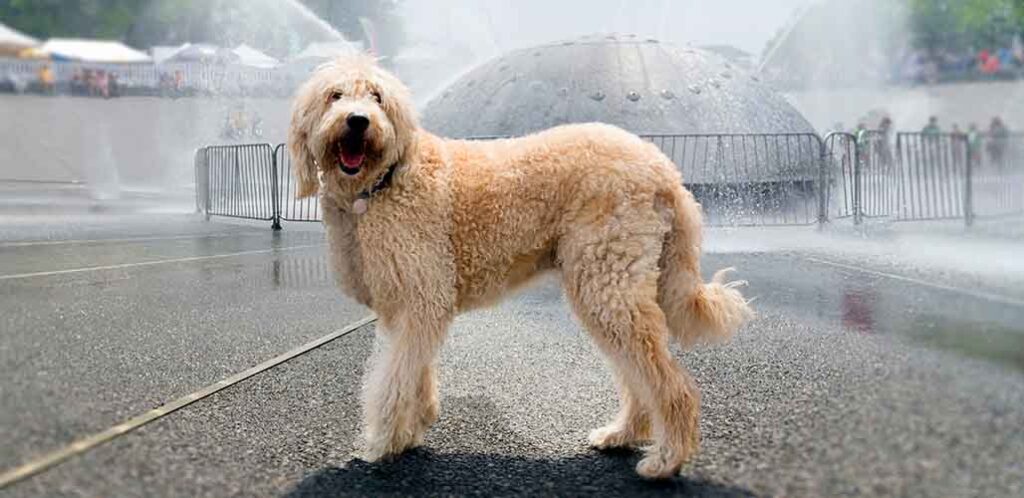Are Labradoodles high maintenance, or easy going? These Lab Poodle mixes need lots of social interaction, physical activity, and mental stimulation, and their coat needs daily grooming. I love these teddy bear dogs, but their needs can be high maintenance in the eyes of some people, and no big deal in the eyes of others. I don’t want to commit to one if I can’t give them all the care they need. So here are the things I’m going to consider.
Contents
- Are Labradoodles high maintenance?
- Do Labradoodles need lots of exercise?
- Are Labradoodles attention seeking?
- Separation: Are Labradoodles OK to be left alone or do they need lots of company?
- Are Labradoodles high maintenance to groom?
- At what age do Labradoodles calm down?
- What are the downsides of owning a Labradoodle?
Are Labradoodles high maintenance?
All dogs need the opportunity to form social bonds with people or other dogs, activities which allow them to express their natural behaviors, and of course, to be physically cared for. In this sense, all dogs are also a big commitment which you need to work on every day. But in all of these respects, there is lots of variety between dog breeds about what, exactly, they entail. It’s very subjective to say that some dog breeds are more high maintenance than others. It’s more accurate to say that people are usually better matched with some dog breeds than others.
In other words, being high maintenance is in the eye of the beholder. So, let’s take a look at some of the qualities which make Labradoodles high maintenance to the wrong owner.
Do Labradoodles need lots of exercise?
Firstly, physical exercise. Labradoodles come from gundog ancestry, and as such they have stacks of energy and stamina. They love to be on the go, and they need at least 2 hours of exercise a day. This can include
- hiking or running with you
- dog sports like canicross, bikejor and flyball
- playing fetch in the backyard
- and swimming.
Without enough outlets for their physical energy, they are likely to get bored, restless and frustrated at home. They could express this through whining and barking, or destructive behaviors like chewing furniture, scratching floors or digging in the sofa cushions. If you’re not usually a fan of the outdoors, or your work and family commitments mean you don’t have 2 hours a day for exercise, then a Labradoodle is probably too much of commitment for you.

Are Labradoodles attention seeking?
Labradoodles are a mix of Labrador and Poodle, which were both originally developed as duck retrievers. This means they needed to be highly motivated to work in cooperation with humans, able to learn lots of training cues, and focussed on their owner out in the field. In other words, we bred them, over many generations, to depend on humans as a fulfilling source of mental stimulation.
Todays Labradoodles are still innately highly motivated to engage in training. They have a strong instinct to seek out human company and interaction. Socializing with them and playing training games together is an important part of meeting their need for social relationships and mental stimulation. If you prefer a more independent dog, then a Labradoodle may feel high maintenance to you.
Separation: Are Labradoodles OK to be left alone or do they need lots of company?
Separation anxiety is one of the most common behavioral problems in Labradoodles. The original Labradors and Poodles spent long hours alongside their owner fetching game birds, and then went home with them at the end of the day to relax with the family. Compare this to, say, the Great Pyrenees, which was bred to spend days at a time watching a field of sheep by itself – and you’ll get a feel for how relatively unadjusted to solitude Labradoodles are. They are not well suited to households which are empty for long periods, and they need to learn to spend time alone very gradually. If this sounds like a chore, or committing to being with them at least 20 hours a day is simply too much, then a Labradoodle might be too high maintenance for you.
Are Labradoodles high maintenance to groom?
Most first generation, F1b, multigen and Australian Labradoodles have a curly, non-shedding coat which needs regular care. This includes:
- Frequent brushing. Long curly coats are very prone to matting, which is painful and increases the risk of skin infections. To keep their coat tangle free, brush it all the way down to the skin every one or two days, paying extra attention to high-friction areas such at the armpits.
- Drying after wet exercise. The Labradoodle’s fleecy coat is a sponge for moisture, promotes matting and fungal skin infections if you don’t dry it off thoroughly after swimming or walking in the rain.
- Regular grooming. Having your Labradoodle’s coat washed and clipped every 6 to 8 weeks will make it easier to brush, dry, and limit how much dirt and debris it can pick up on walks.
On top of these grooming commitments, Labradoodles also need their nails trimming, ear cleaning and drying, and teeth cleaning. With a bit of experience and time spent on counter conditioning (and potentially outsourcing the grooming to a professional) Labradoodle owners can master grooming their adult dogs pretty efficiently. But Labradoodle’s grooming needs are high maintenance by anyone’s standard. And since Poodle crosses started to surge in popularity nearly 30 years ago, dog groomers have reported a huge increase in severely matted dogs needing help. Which suggests that a lot of people do underestimate how high maintenance they are in this respect.
What are the downsides of owning a Labradoodle?
The potential downsides of of owning a Labradoodle that we’ve looked at so far are:
- They need a lot of exercise.
- They need a lot of training and mental stimulation.
- Their coat is expensive and labor intensive to care for.
- They are prone to separation anxiety.
Some other difficult Labradoodle behaviors most commonly reported by Labradoodle owners are:
- Dog rivalry. Aggression directed towards familiar dogs within their own household.
- Touch sensitivity. Such as unwillingness to have their fur brushed, ears dried, or nails clipped.
- Non-social fear. For example fear of thunder, traffic, or fireworks.
- Mouthing. Gripping hands or clothing in their mouth.
Dog rivalry is a more common problem in Miniature Labradoodles, since it is associated with Miniature Poodles rather than Standard Poodles or Labs. Researchers have tentatively linked it to the presence of a gene called IGF-1, which also causes their small size.
Inconvenient mouthing behavior is strongly inherited from Poodles – it not commonly reported in Labs. So this might be more prevalent in F1b dogs and Australian Labradoodles (which are usually much closer genetically to Poodles than Labs).
At what age do Labradoodles calm down?
Lots of the traits which make Labradoodles time consuming and high maintenance as puppies are somewhat linked to age. They often become less burdensome as your dog gets older.
For example, a lot of the impulsive behavior and wild zoomies which require your constant vigilance will subside a little or a lot after adolescence. And their working ancestry means they love having a purpose, but you can teach them that lying calmly on their bed is a rewarding part of their role too.
Depending on their individual temperament and your training, most Labradoodles calm down a bit around their first birthday, a bit more at the end of adolescence, and more still when they reach about 3 years old.
Are Labradoodles high maintenance – summary
Labradoodles live for fun, activity, and human connections. Their coat is undeniably high maintenance compared to other dogs. But their need for exercise and mental engagement is only subjectively high maintenance. It’s too much for some dog owners, but exactly the rewarding partnership that other dog lovers are looking for.
Do you think Labradoodles sound high maintenance? Let us know in the comments box down below!
More useful information about Labradoodles
- Are Labradoodles good first dogs?
- Are Labradoodles water dogs?
- Looking after a Labradoodle’s fleecy coat
- Grooming tips
- How long can you leave a Labradoodle home alone?
- Are Labradoodles protective?
References
- Ali et al. Genetic analysis of the modern Australian labradoodle dog breed reveals an excess of the poodle genome. PLOS Genetics. 2020.
- McDonald et al. Grooming-Related Concerns Among Companion Animals. Frontiers in Veterinary Science. 2022.
- Shouldice et al. Expression of Behavioural Traits in Goldendoodles and Labradoodles. Animals. 2019.
- Waite et al. Frequency and animal demographics of mouthing behavior in companion dogs in the United States. Learning and Motivation. 2021.

